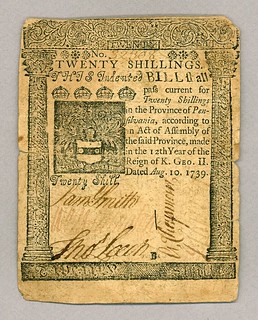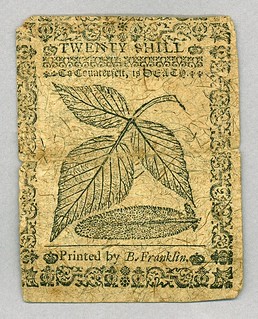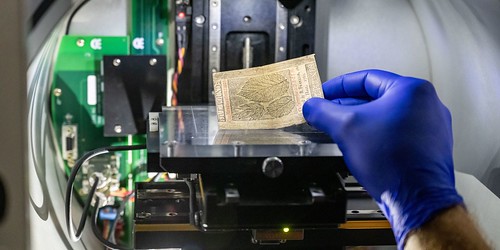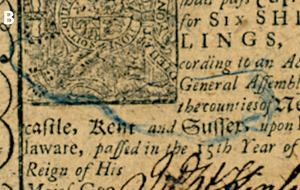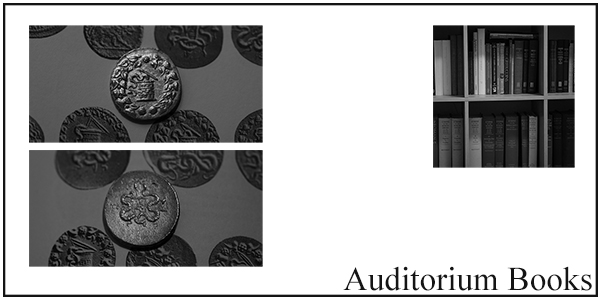
PREV ARTICLE
NEXT ARTICLE
FULL ISSUE
PREV FULL ISSUE
BEN FRANKLIN'S MONEY PRINTING TECHNIQUESSpeaking of the cat and mouse game between security printers and counterfeiters, a new study of Ben Franklin's paper money printing techniques is getting a lot of mainstream press. Gerry Tebben submitted these thoughts. Thanks. -Editor The best thing about newspapers is you never know what you're going to find. The New York Times reports on a paper about Benjamin Franklin's printing techniques that was just printed in the Proceedings of the National Academy of Sciences. The Times story says, "During his printing career, Franklin produced a stream of baroque, often beautiful money. He created a copper plate of a sage leaf to print on money to foil counterfeiters: The intricate pattern of veins could not easily be imitated. He influenced a number of other printers and experimented with producing new paper and concocting inks."
Here's a link to the Times article:
I don't have access of the National Academy article, but the abstract available to non-subscribers makes me want to find a way to read it. The authors analyzed 600 18th century notes. The abstract says,
"Franklin used natural graphite pigments to print money and developed durable 'money paper' with colored fibers and translucent muscovite fillers, along with his own unique designs of
Here's a link to the abstract:
Here's an excerpt from the New York Times piece. -Editor When Benjamin Franklin moved to Philadelphia in 1723, he got to witness the beginning of a risky new experiment: Pennsylvania had just begun printing words on paper and calling it money. The first American paper money had hit the market in 1690. Metal coins never stayed in the 13 colonies long, flowing in a ceaseless stream to England and elsewhere, as payment for imported goods. Several colonies began printing bits of paper to stand in for coins, stating that within a certain time period, they could be used locally as currency. The system worked, but haltingly, the colonies soon discovered. Print too many bills, and the money became worthless. And counterfeiters often found the bills easy to copy, devaluing the real stuff with a flood of fakes. During his printing career, Franklin produced a stream of baroque, often beautiful money. He created a copper plate of a sage leaf to print on money to foil counterfeiters: The intricate pattern of veins could not easily be imitated. He influenced a number of other printers and experimented with producing new paper and concocting inks. The study draws on more than 600 artifacts held by the University of Notre Dame, said Khachatur Manukyan, a physicist at that institution and an author of the new paper. He and his colleagues looked at 18th-century American currency using Raman spectroscopy, which uses a laser beam to identify specific substances like silicon or lead based on their vibration. They also used a variety of microscopy techniques to examine the paper on which the money was printed. Some of what they observed confirms what historians have long known: Franklin's paper money contains flecks of mica, also known as muscovite or isinglass. These shiny patches were most likely an attempt to combat counterfeiters, who would not have had access to this special paper, said Jessica Linker, a professor of American history at Northeastern University who studies paper money of this era and was not involved in the study. Of course, that didn't stop them from trying.
In the new study, the researchers found that the mica in bills for different colonies seems to have come from the same geological source, suggesting that a single mill produced the paper. The Philadelphia area is notable for its schist, a flaky mineral that contains mica; it's possible that Franklin or printers and papermakers associated with him collected the substance used in their paper locally, Dr. Manukyan said. Gerry writes: "The Wall Street Journal has an even better report. The online presentation has some great photos that are not present in the printed version of the newspaper. " The researchers took samples from the paper money and examined them in increasingly fine detail using a variety of microscopes, including a high-resolution model that passed beams of electrons through the samples to produce images of the atomic details.
Researchers discovered that the black ink used by Franklin and his associates was made of graphite. The blue threads in their bills were dyed with indigo, a plant-based pigment. Their paper was strengthened with muscovite, a variety of mica. Combined, the features created bills that were more durable and of a higher quality, Manukyan said.
Bills produced by other printers included in the analysis used lamp-black or bone-black ink; Prussian blue, a mineral-based pigment; and a more common type of paper strengthened with kaolinite, a clay mineral.
To read the complete article (subscription required), see:
Thanks also to Howard Berlin, Stephen Searle, Arthur Shippee, Len Augsburger, and others who passed along articles from the NYT, WSJ and elsewhere on this topic. -Editor
To read the additional articles, see:
Wayne Homren, Editor The Numismatic Bibliomania Society is a non-profit organization promoting numismatic literature. See our web site at coinbooks.org. To submit items for publication in The E-Sylum, write to the Editor at this address: whomren@gmail.com To subscribe go to: https://my.binhost.com/lists/listinfo/esylum All Rights Reserved. NBS Home Page Contact the NBS webmaster 
|
